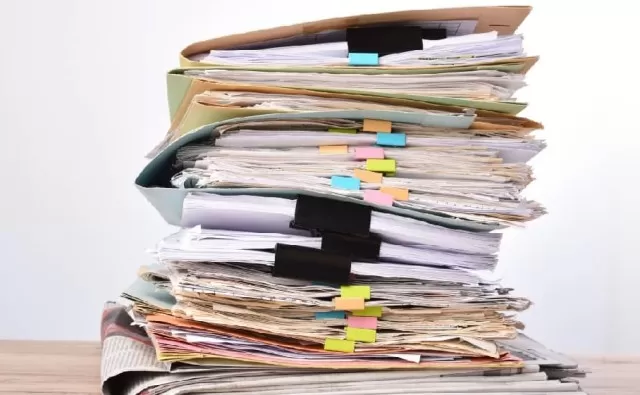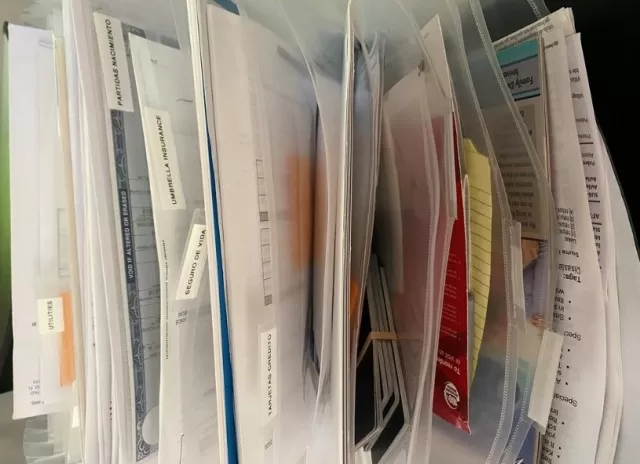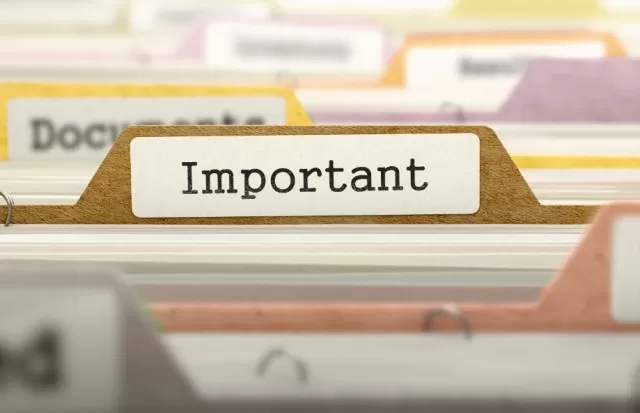Employ these ingenious suggestions to organize your paperwork and maintain an orderly system.
Tackle the challenge of countertop clutter caused by receipts, bills, mail, and important documents by implementing effective strategies for sorting and storing paperwork.
Employ these ingenious suggestions to organize your paperwork and maintain an orderly system.
Ways to Organize Important Documents

Consolidated Storage: Gather all the items necessary for a specific task and keep them in one designated area.
For instance, if you frequently need to write notes and address envelopes, utilize a desktop organizer to store writing utensils and supplies. Less frequently used items can be stored in nearby boxes or bins on upper shelves, keeping them accessible but out of the way.
Streamlined Paperwork: Avoid the hassle of searching for important documents by using an effective organizer for your essential papers.
A lidded file box serves as an excellent solution, or you can opt for stackable plastic bins to maintain order. Dedicate some time each month to sort through these containers, discarding unnecessary items and archiving past bills and receipts in a separate file.
Concealed Storage: Create an easily accessible yet hidden storage space for your essential paperwork, keeping it out of sight from guests.
Install built-in shelves and pockets inside a shallow cabinet in your kitchen or office, allowing you to store items that would typically clutter refrigerator doors, countertops, and desks. When you close the cabinet door, the storage area remains concealed, contributing to a neat appearance.
Action-Oriented Organization: Simplify the organization of incoming mail and papers by utilizing separate slots or compartments for different actions.
Whether it’s a permission slip, bill, or birthday card, this straightforward system helps you keep track of items that need to be sent and those that are yet to be opened. Regularly maintain this system to prevent the “to-be-filed” area from overflowing and ensure timely handling of action items.
Efficient Filing: Set up filing cabinets within your household to manage important documents and other papers you wish to keep, such as your kids’ school projects.
Organize your files with clear labels and allocate time to sort all your documents into appropriate sections. By establishing an organized filing system from the start, you’ll find it easier to maintain order in the long run.

Dedicated Document Organizer: Designate a specific cabinet or closet as your space for organizing important documents, separate from your main desk area.
Lidded file boxes and stacked drawers provide practical solutions for keeping each family member’s papers and school projects tidy manner. Attach labels to the front of each drawer or bin to ensure everyone knows their designated spot.
Wall-Mounted Files: Install hanging magazine holders on your wall to efficiently organize mail and other documents.
Opt for wire files that offer visibility and freshness in your mind. Label each hanging file according to the document type, enabling quick and easy sorting.
Rolled Storage: If you need an accessible storage option for craft paper and supplies, consider installing wall organizers that facilitate a simple and organized approach.
For large craft paper sheets, roll them up with the printed side facing out and secure them with paper clips. This way, you can easily view the available colors and patterns.
Wire baskets provide visibility for stored supplies, and labels make tidying up a breeze.
Convenient Cubbies: Utilize built-in cubbies within a desk or cabinet to store loose papers and other office essentials.
Assign each family member their cubby and add file sorters to keep their documents organized. Organizing paperwork by individual family members helps you stay on top of your mail and easily track your kids’ papers.
Attractive Display: Keep photos, invitations, and memos organized and within reach by using an appealing wall-hanging organizer.
Opt for a customizable design that allows you to arrange the items according to your storage needs. This stylish solution not only functions as wall decor but also ensures everything is readily available when you need it.
Space-Saving Communication Center: Synchronize your family’s busy schedules by creating a communication center in a central location like the Home Office, kitchen, or entryway.
Many wall-mounted organizers, such as bulletin boards and wire file holders, maximize vertical space, freeing up drawers and desk surfaces for other purposes. Use labels to designate areas for each family member or categorize paperwork based on activities.
Additionally, reserve space on the bulletin board for hanging cards, artwork, or posting messages.

Handy Reading Material: Instead of storing magazines in filing cabinets where they can be forgotten, keep reading material easily accessible with an attractive basket or bin that complements your decor.
Remember to regularly purge old or untouched items to prevent a buildup of unnecessary papers.
Budget Management: Simplify budget management and keep important documents at hand by using a well-organized letter tray.
Choose one with multiple stacked sections, allowing you to sort bills, receipts, mail, and other statements while occupying minimal desk space. Label each tray to facilitate quick sorting of information.
Customized Command Center: Create a family command center to control paper clutter.
A modular wall organizer offers a practical solution for keeping papers at hand while minimizing desk clutter. Use each compartment to organize items by a family member or categories, such as bills, schoolwork, and notepads.
Install metal hooks nearby for conveniently storing keys and other items you frequently grab before heading out.
Message Management: Keep clutter in check with a versatile workstation that serves multiple purposes.
This communication hub consists of magnet, dry-erase, chalkboard, cork, and pegboard squares integrated behind the built-in desktop. The combination of materials allows for the versatile storage of messages and papers.
Utilize magnetic boards for temporarily holding papers, dry-erase boards, chalkboards for quick messages and to-dos, corkboards for sticking more permanent papers like favorite take-out menus and emergency phone numbers, and pegboard squares to mount containers for desk supplies.
Personalized Filing System: When organizing paperwork, create a filing system that suits your needs, even if it deviates from traditional methods.
A dish-drying rack, for example, can effectively store file folders and notebooks. Utilize the slotted compartments designed for sponges to store small office supplies such as pens, pencils, and notepads.
Tray Dividers: Divide storage space within desk drawers to prevent loose papers from causing chaos.
Quarter-sheet baking pans serve as great catch-all trays in shallow drawers. Assign each tray for specific needs, whether it’s organizing bills, keeping mail supplies, or storing extra office essentials.
By doing so, you can maintain a clear desk surface.

Hanging Clipboards: Create a vertical paper organizing station by hanging a group of clipboards on the wall.
Attach labels to designate the function of each clipboard, whether it’s for posting invitations to upcoming events or storing bills awaiting payment. Before hanging them, apply chalkboard paint to each clipboard to create a surface for jotting down messages and to-do lists.
Kids’ Paperwork Organization: Establish a simple filing system for organizing homework and school papers.
Standing files with tabbed dividers allow you to sort documents by subject or activity, making it easy to separate classes from extracurriculars. Add various desktop organizers to keep frequently used supplies like pencils, scissors, and paper clips within easy reach.
On-the-Go Organization: Use an index card case to create a portable organizer for coupons and receipts.
Alphabetized divider tabs facilitate easy sorting, eliminating the need to search for a specific receipt. The compact size of the mini file folder allows for easy storage in a purse, ensuring you remember to take it with you when running errands.
Mail Sorting Station: Allocate a designated spot for incoming mail to prevent it from piling up on the countertop.
Mount an organizer like a wall file pocket in a convenient location near the entryway. Ensure it is spacious enough to accommodate larger items such as magazines or catalogs.
Savvy Shelving: Maximize unused wall space to contain clutter by utilizing hanging organizers.
Repurpose items like metal poultry feeders mounted on iron shelf brackets and use magnetic strips to secure contents in place. Different sections on top help sort mail, cards, and receipts.
Simplify organization with magnetic labels and store small supplies like rubber bands and paper clips in mini canisters.
By implementing these diverse organization methods, you can create a more efficient and clutter-free environment, ensuring important documents are easily accessible and everyday tasks are streamlined.
*The information is for reference only.